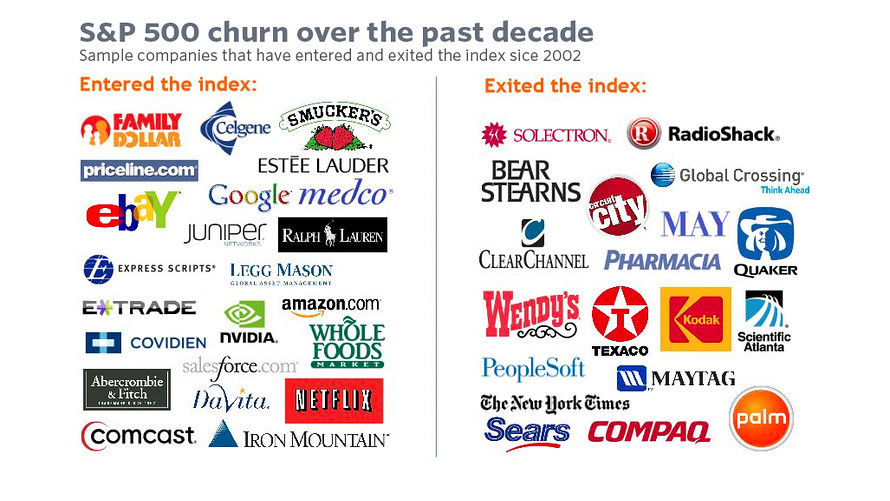Embrace ‘creative destruction’ or become a casualty of ‘digital Darwinism’
by: Brian Solis, MarketWatch
Back in 1958, the U.S. companies in the S&P 500 had been part of the benchmark stock market index for an average of 61 years. By 1980, the average tenure of a S&P 500 component was 25 years. By 2011, that average was just 18 years, based on seven-year rolling averages. At this rate, 75% of the S&P 500 will be replaced by 2027.
What’s been happening to the S&P 500 SPX, +0.46% is accelerated “churn,” as Richard Foster of consulting firm Innosight noted in his 2012 paper, ”Creative Destruction Whips Through Corporate America.” And both companies and their investors should take this development seriously if they expect to stay ahead of the game.
Here’s Foster’s stark reality for business leaders: “As we head into a time of stronger growth coupled with increased technological change, the message for senior executives is clear: if you aim to maintain control of your corporation and deliver value to shareholders and customers, you must embrace creative destruction rather than wait to become a victim of this unstoppable force.”
Creative destruction is an economic innovation theory introduced by Joseph Schumpeter in the 1950s. It describes the process of industrial (r)evolution that “incessantly revolutionizes the economic structure from within, incessantly destroying the old one, incessantly creating a new one.”
As a digital analyst and anthropologist, I study disruptive technology’s effect on business and society. I call this “digital Darwinism.” It’s a modern-day take of creative destruction through the lens of disruptive technology.
The effect of digital Darwinism on Corporate America is real, and it’s enlivened though evolutionary changes in people (customers, employees, and business partners) — how they think, learn, and make decisions; what they expect, prefer, and value; how they influence and are influenced. The question is, at what pace or extent is a company tracking against digital Darwinism in its industry?
In my research, I’ve found the answer to digital Darwinism or “creative destruction” lies in one of the most promising and impactful trends in business today. Flying under the banner of what’s called “digital transformation,” executives are alerting shareholders and employees alike to dig in for the long haul as they retrofit and innovate for disruptive times. Digital transformation carries with it the ability to renovate business for a digital economy to make it, from the inside out, more competitive and agile in an era shaped by constant change.
This shift starts with leadership and the courage to see and do things differently. Unilever ULVR, +0.69% CEO Paul Polman, for example, did away with quarterly reports and earnings guidance when he took office. In order to position Unilever for success, he set out to redefine business norms and values rather than bowing to pressure to focus on the bottom-line at all costs.
It’s risky to make such bold moves, but that’s the difference between leadership and management cultures. “But that’s the way it’s always been done…,” is not something you will ever hear from a successful leader or entrepreneur.
Over the last several years, I’ve studied digital transformation and how businesses were changing in the face of technological disruption. One of the primary catalysts for immediate and sustainable change places a significant emphasis on radically updating customer experience. And this is only gaining momentum.
As a result, I define it this way: Digital transformation as the realignment of, or new investment in, technology, business models, and processes to create new value for customers and employees and more effectively compete in an ever-changing digital economy.
The path to transformation is most often shaped by the person or group leading the effort, which can limit the implementation of holistic, persistent, and meaningful change. For example, a company’s chief information officer or chief digital officer may drive digital investments from an operational or technological perspective without tapping either customer empathy or the knowledge of how and why new expectations, preferences, and values are disrupting markets. At the same time, chief marketing officers may invest in technology that scales digital customer marketing and engagement, without realizing the consequences of not involving the rest of the organization. The same is true for any effort led or governed by only one facet of the company.
Digital transformation requires a modern, human, market-focused perspective to guide research, collaboration, and innovation. I’ve looked at the maturation of some of the world’s leading brands — including Dell, Discover, General Motors, Harvard University, Lego, the Metropolitan Museum of Art, Nestlé, Novartis, Sephora, Starbucks, and Target. This research produced a new report, “The Race Against Digital Darwinism: Six Stages of Digital Transformation,”which documents the technology, business models, and processes that companies need to compete in the digital economy.
What’s clear is that creative destruction and digital Darwinism is increasingly prevalent. Accordingly, companies must innovate, market, sell, and serve in ways that are relevant and resilient. Otherwise management will have nothing to return to shareholders and stakeholders other than an apology.






Leave a Reply